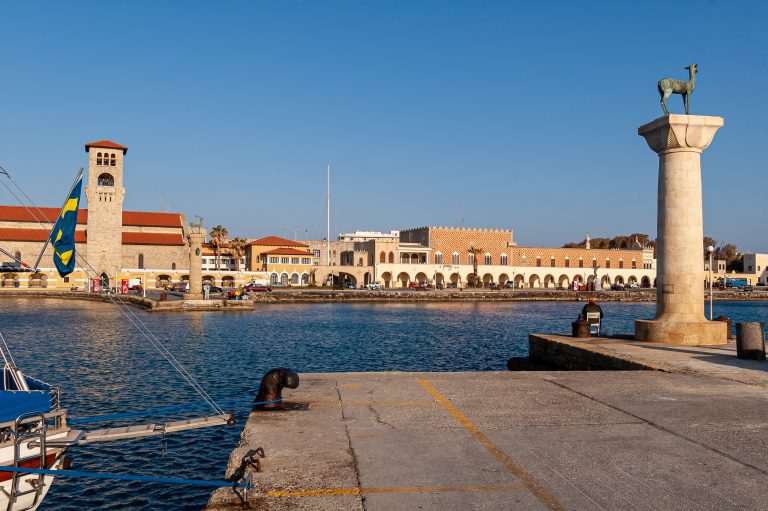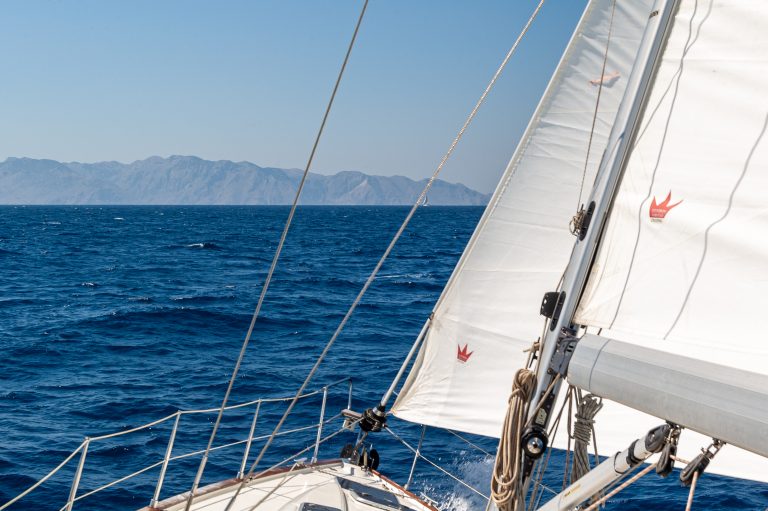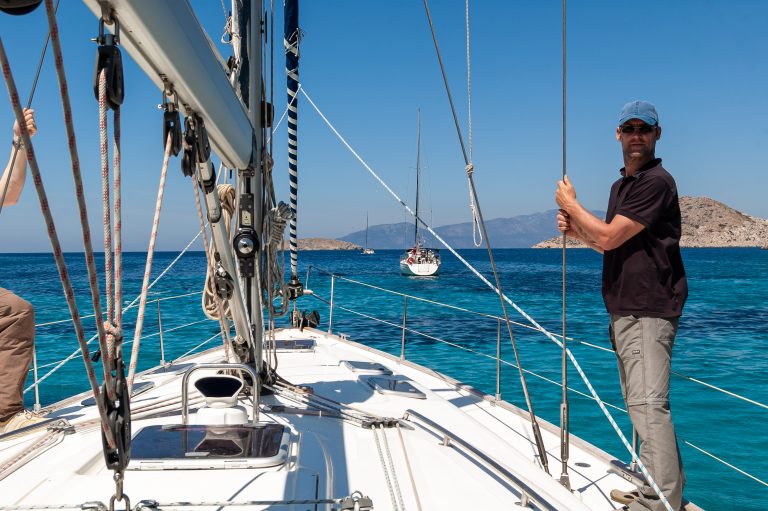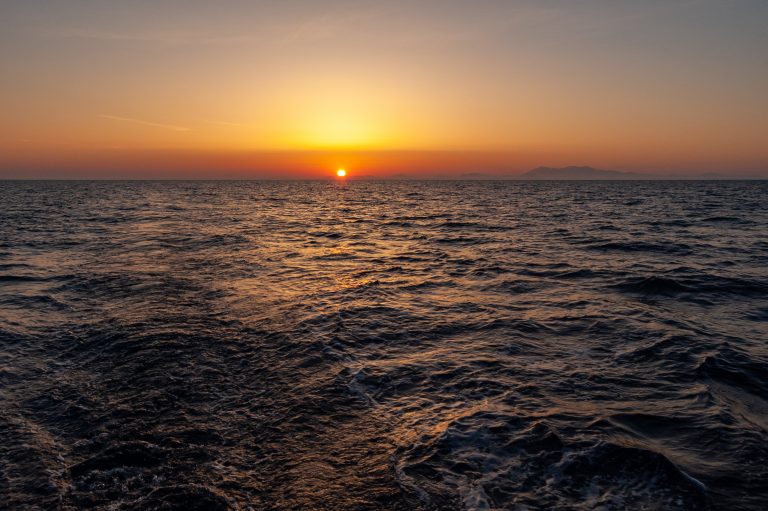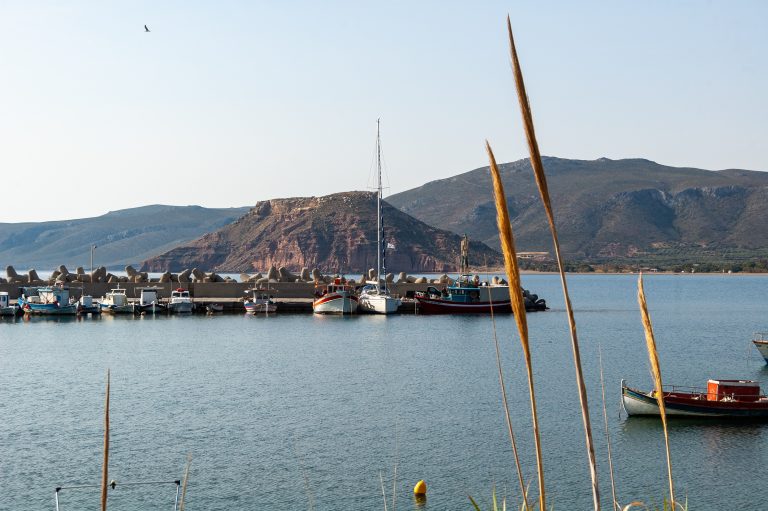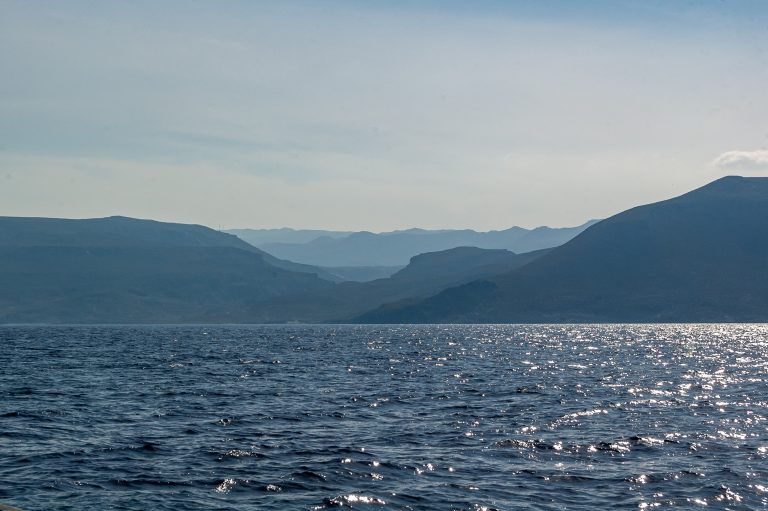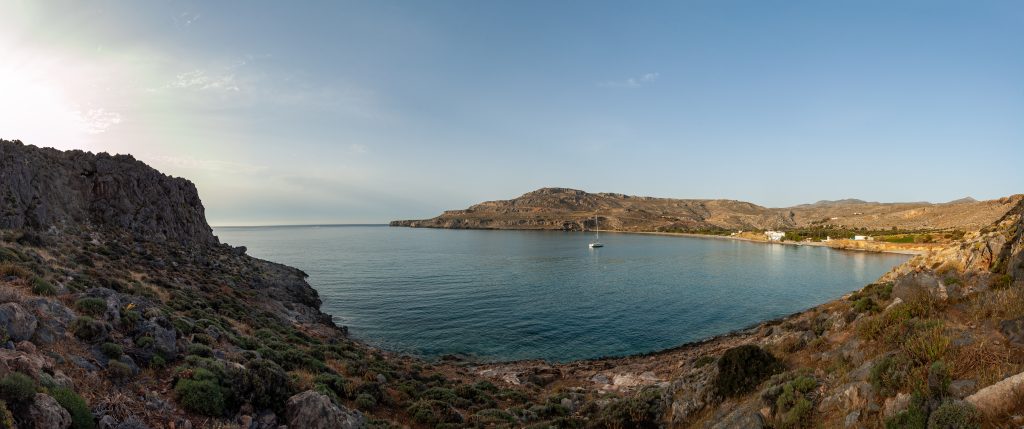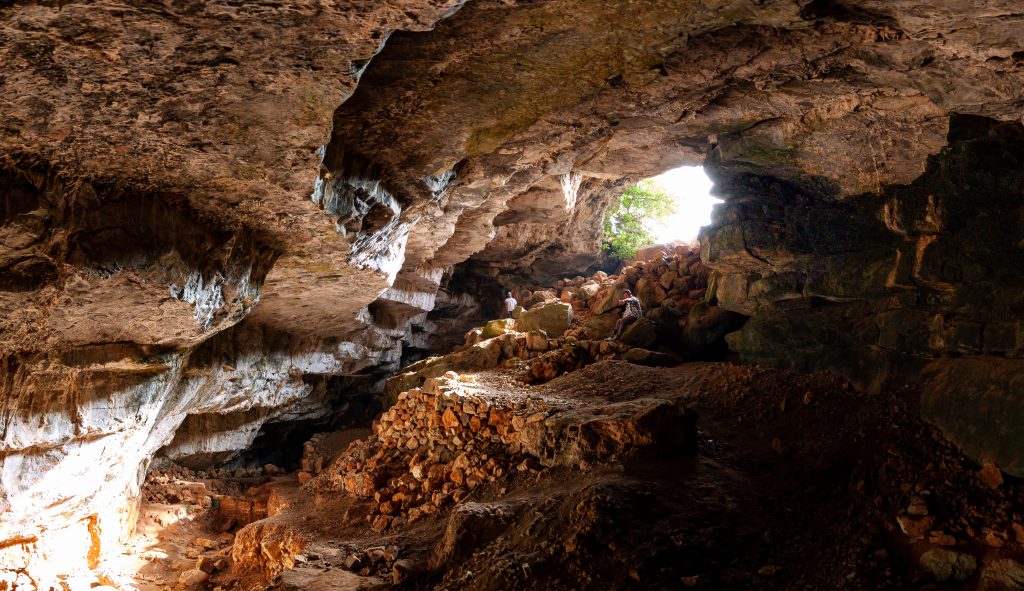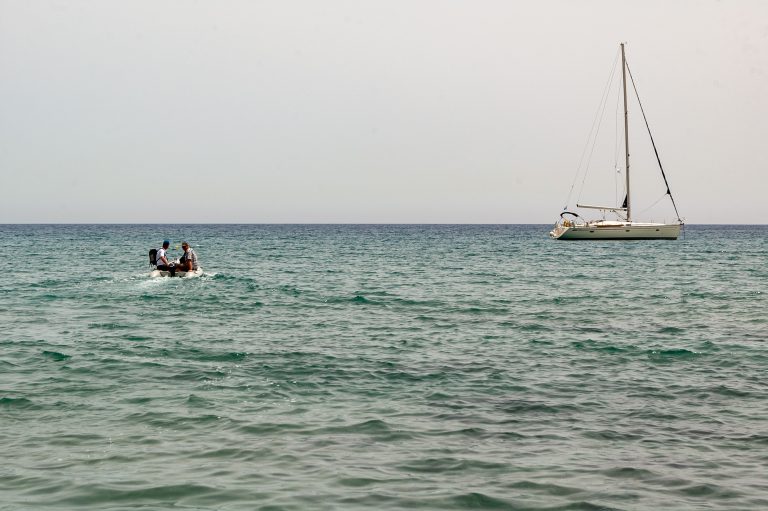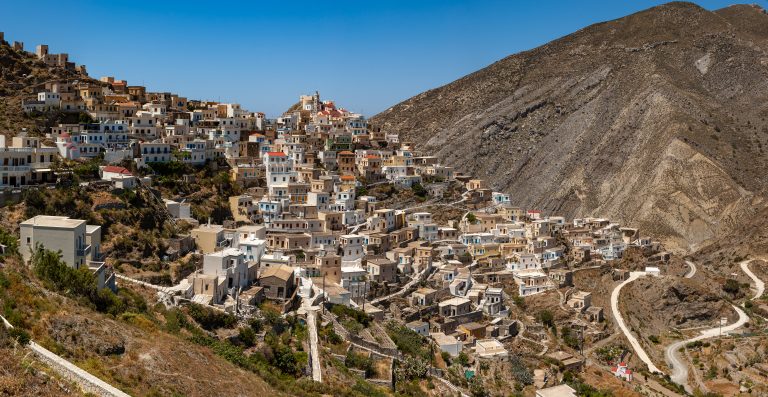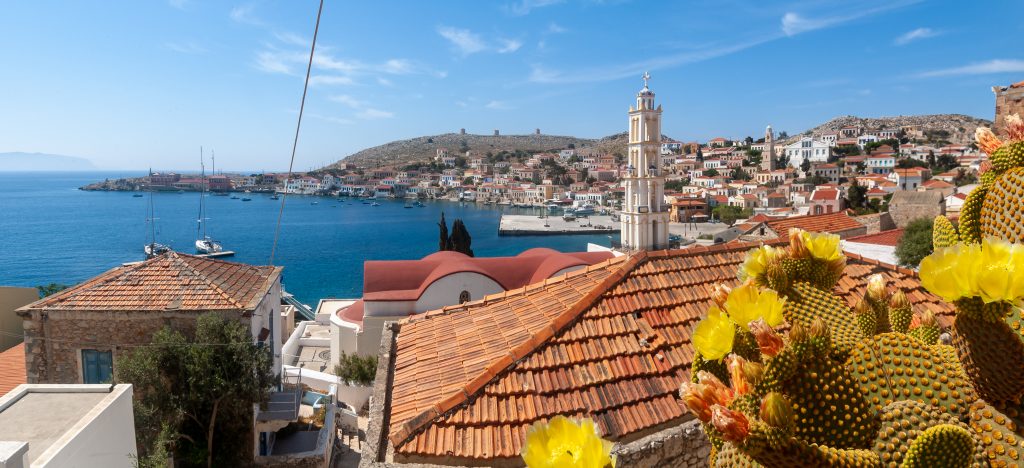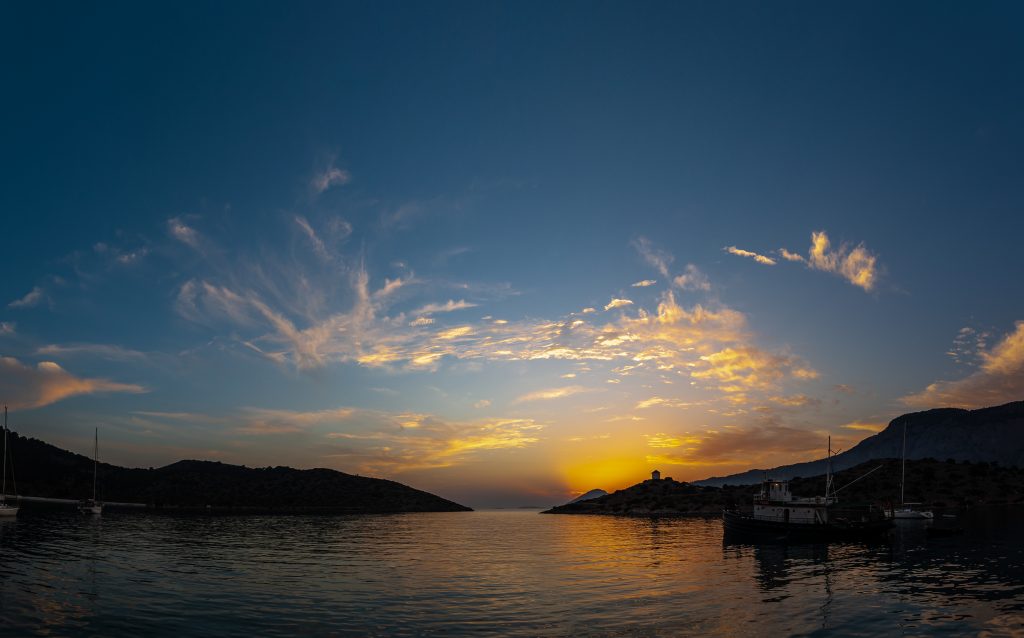
Rhodos – Kreta – Rhodos
Rhodes – Crete – Rhodes
Wieder einmal waren die Routenpläne ehrgeiziger als unsere Umsetzung. Wir durchquerten also nicht, wie geplant, die See von Rhodos, sondern kürzten den Weg über Karpathos und Chalki ab.
Und das kam so…
Once again, the route plans were more ambitious than our realization. So we did not cross the sea of Rhodes as planned, but shortened the way via Karpathos and Chalki.
And that’s how it happened …
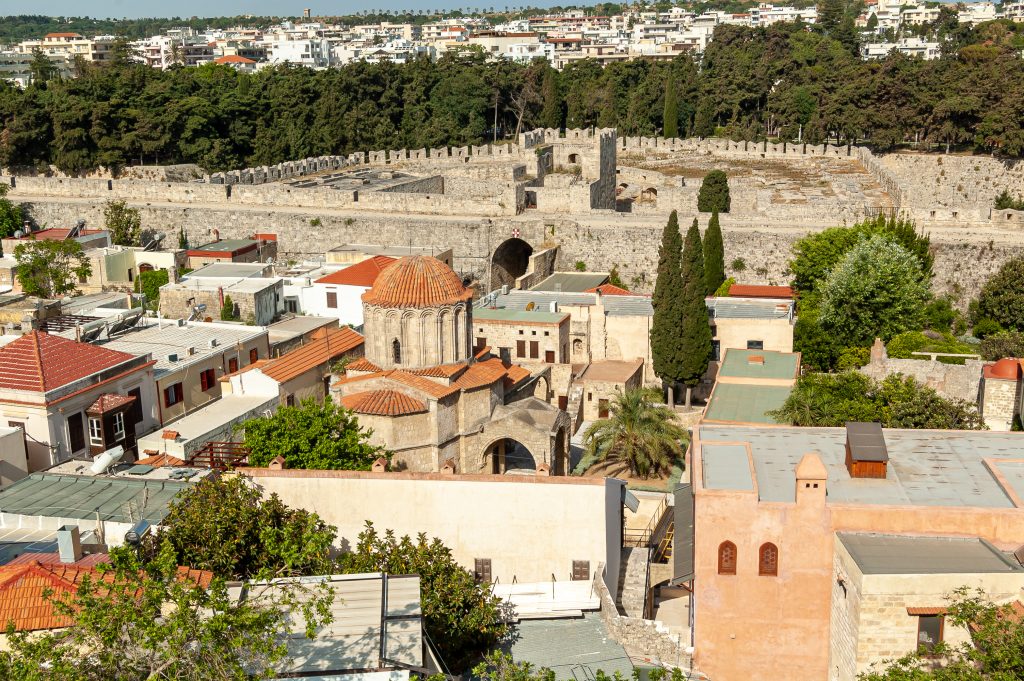
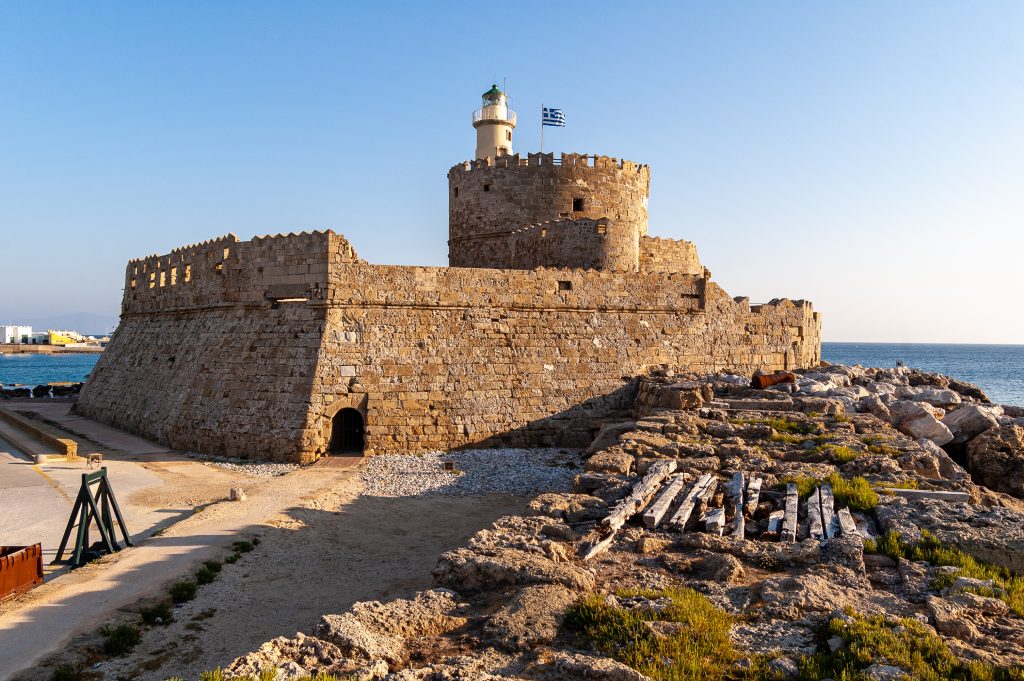
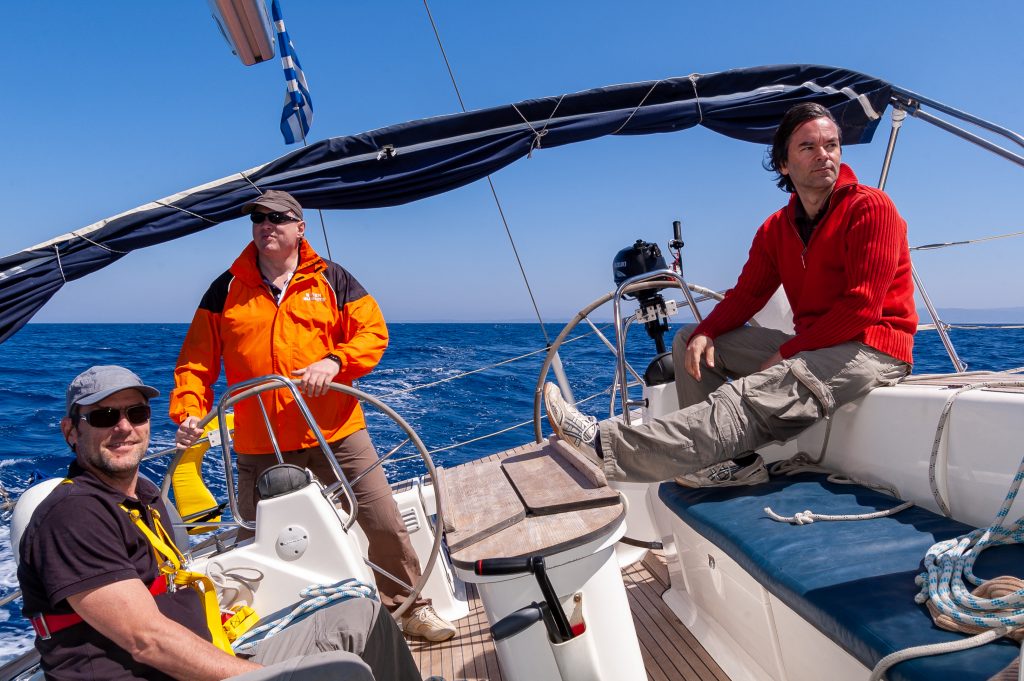
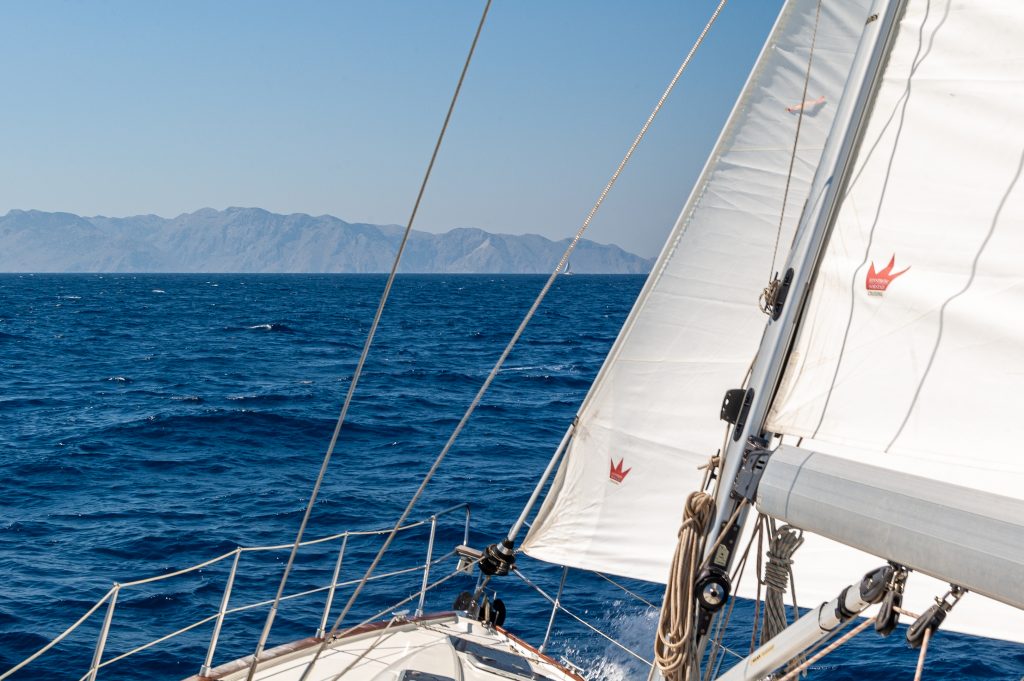
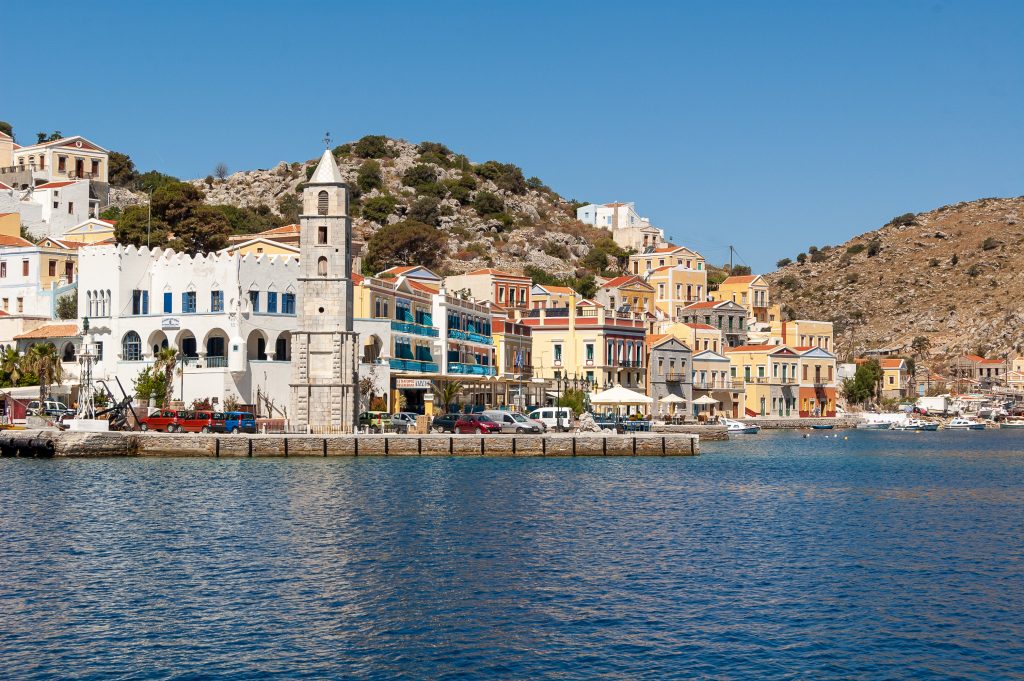
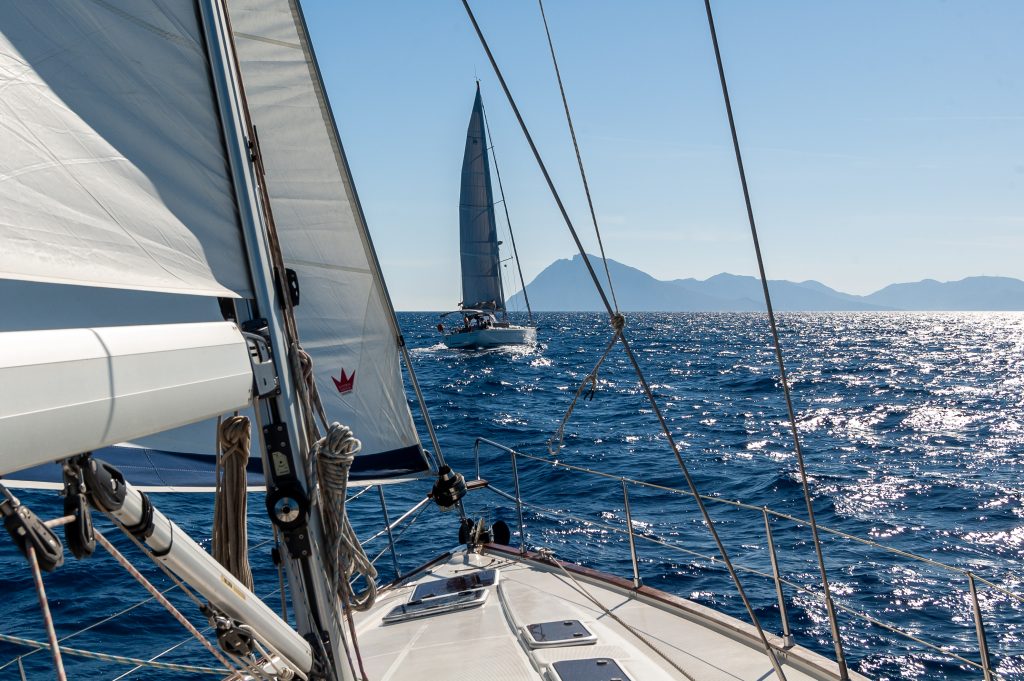

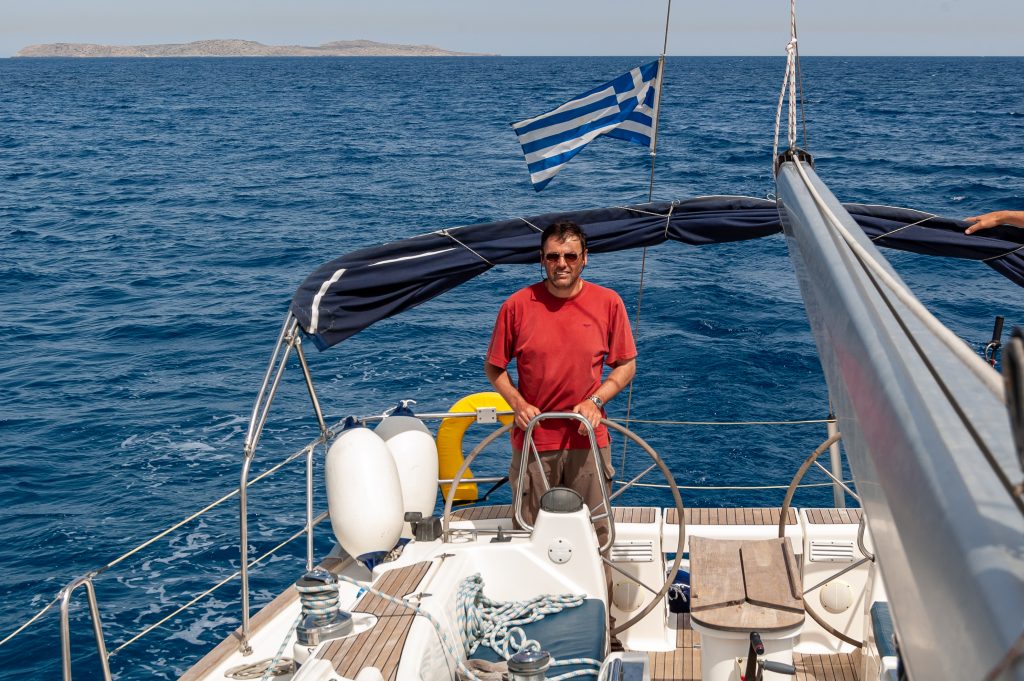
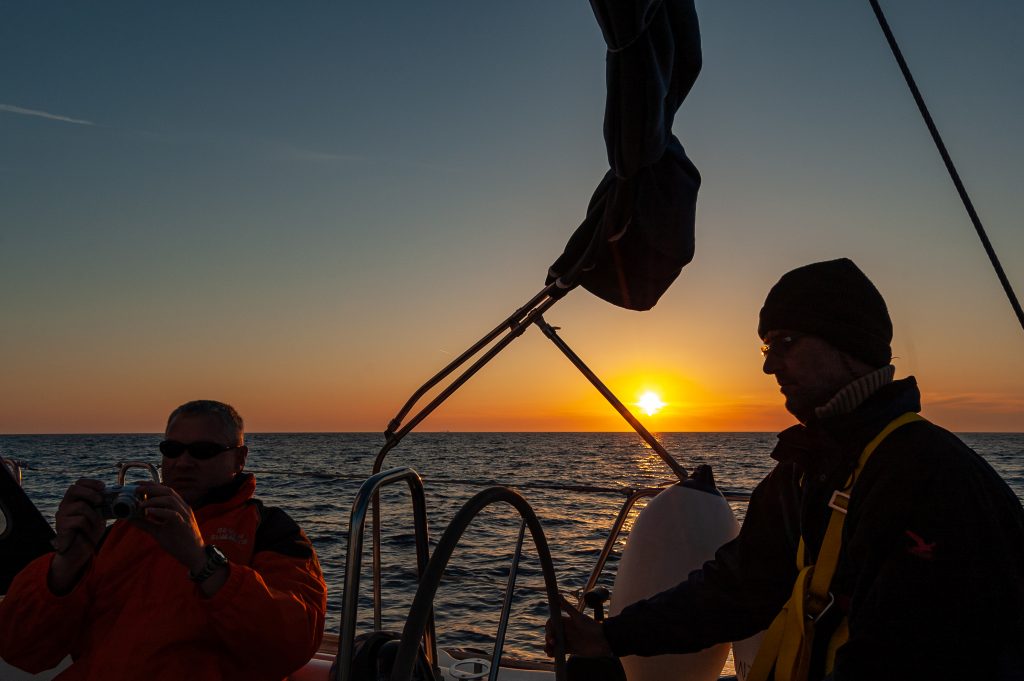
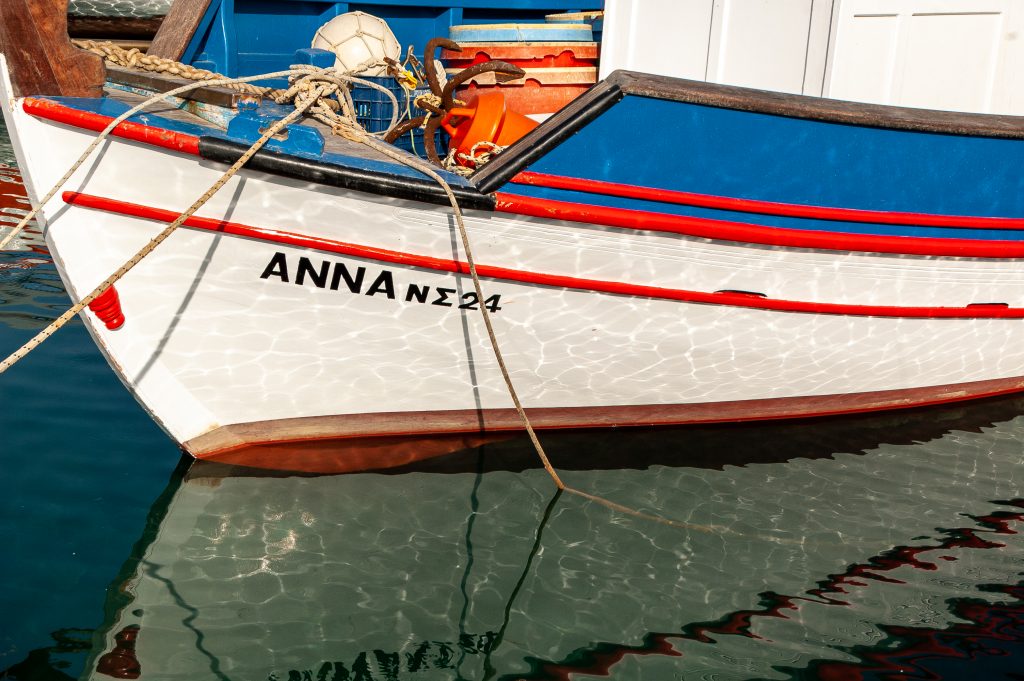
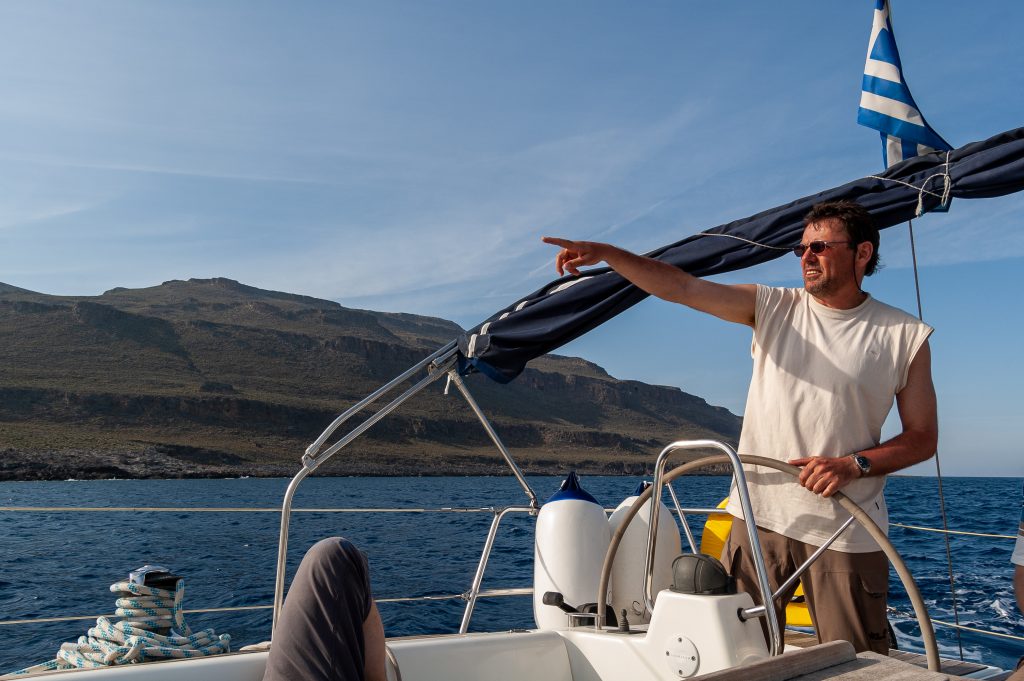
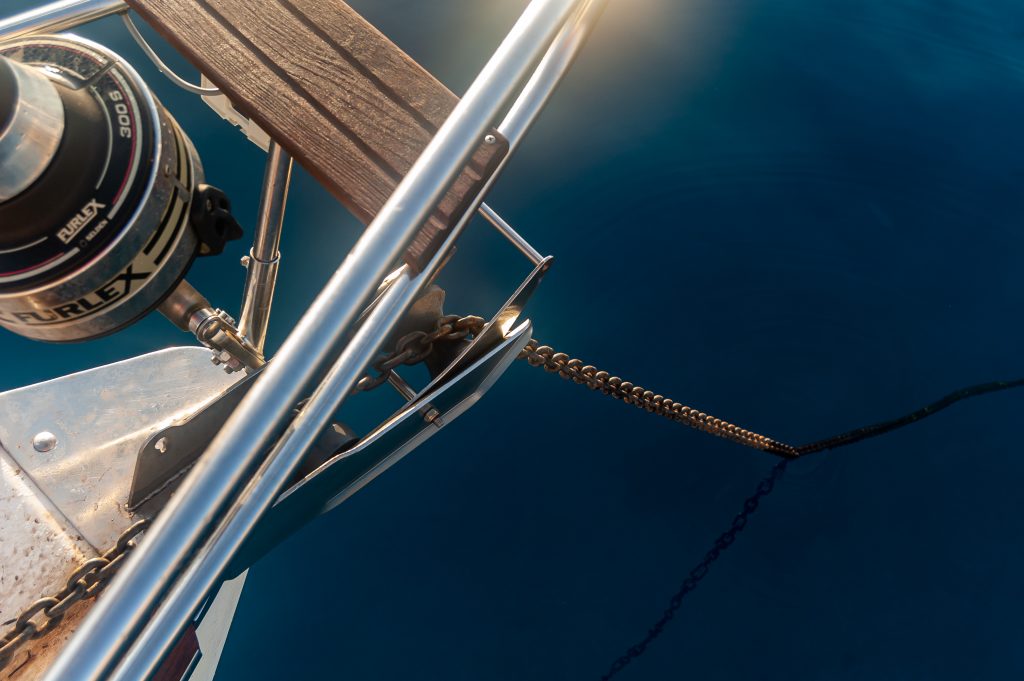
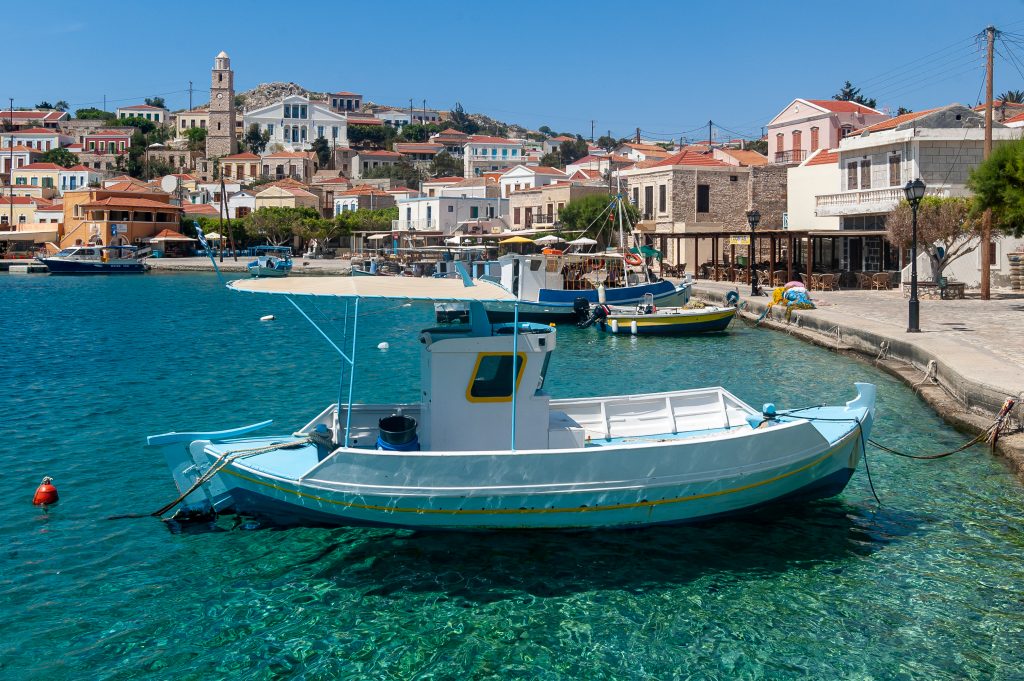
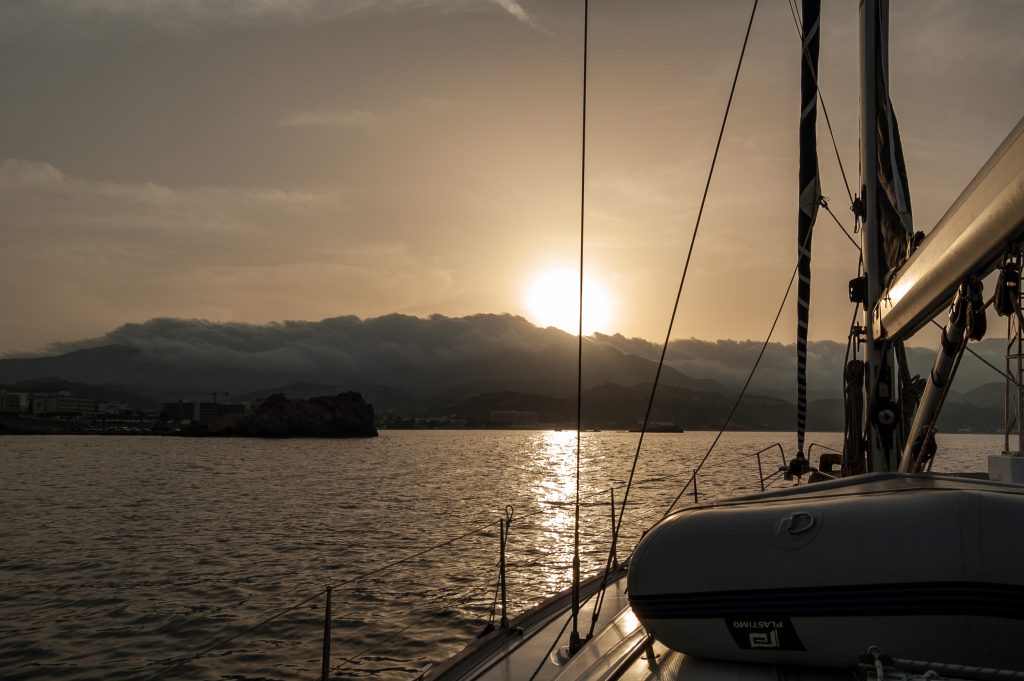
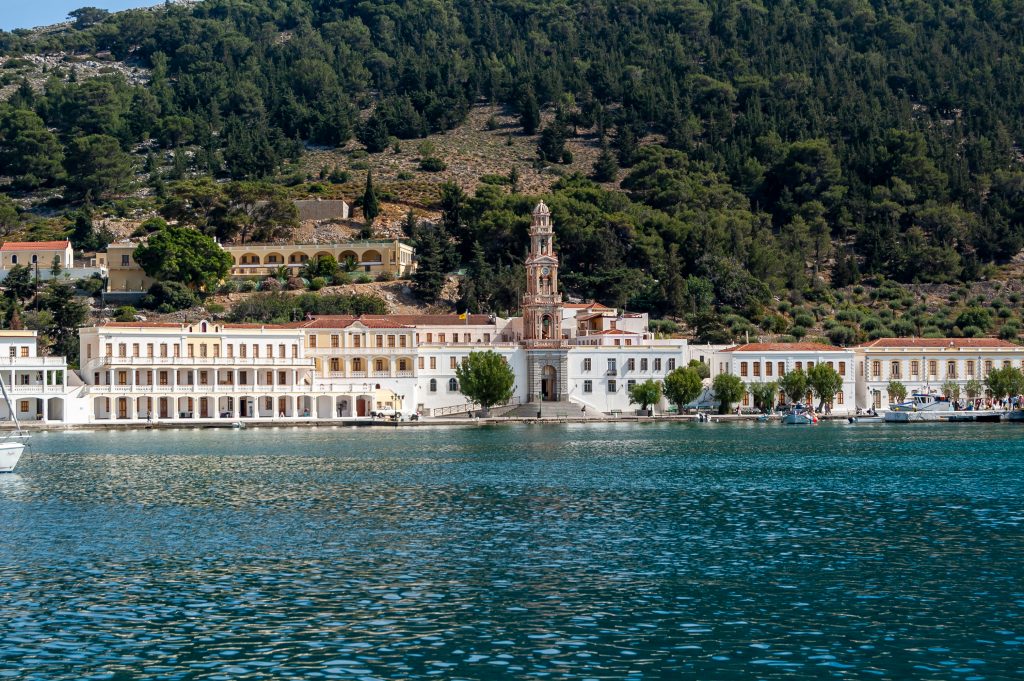
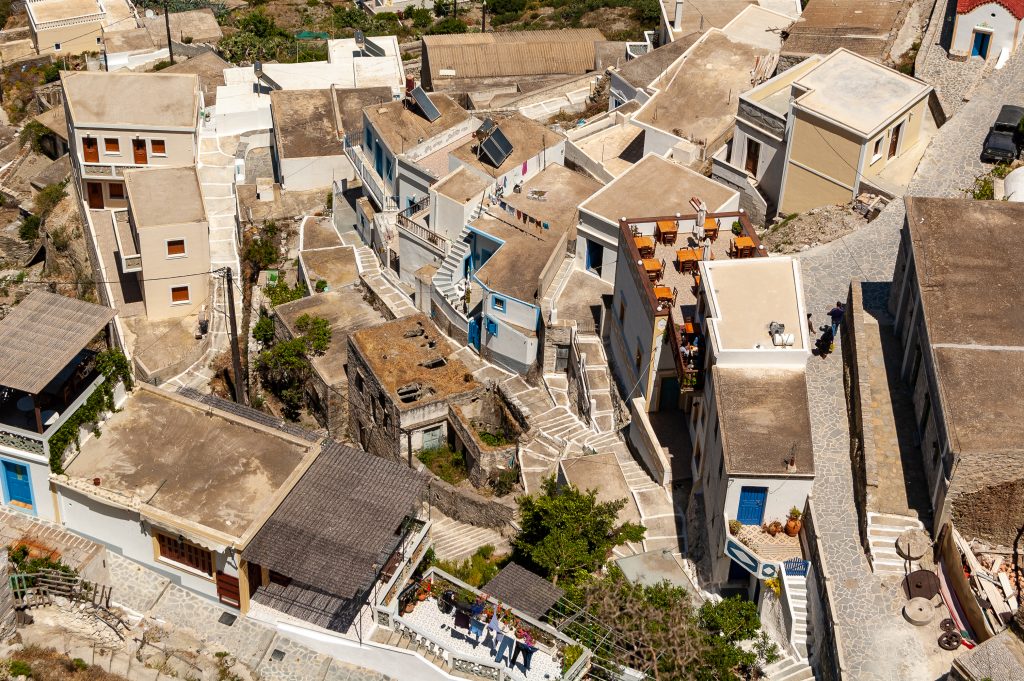
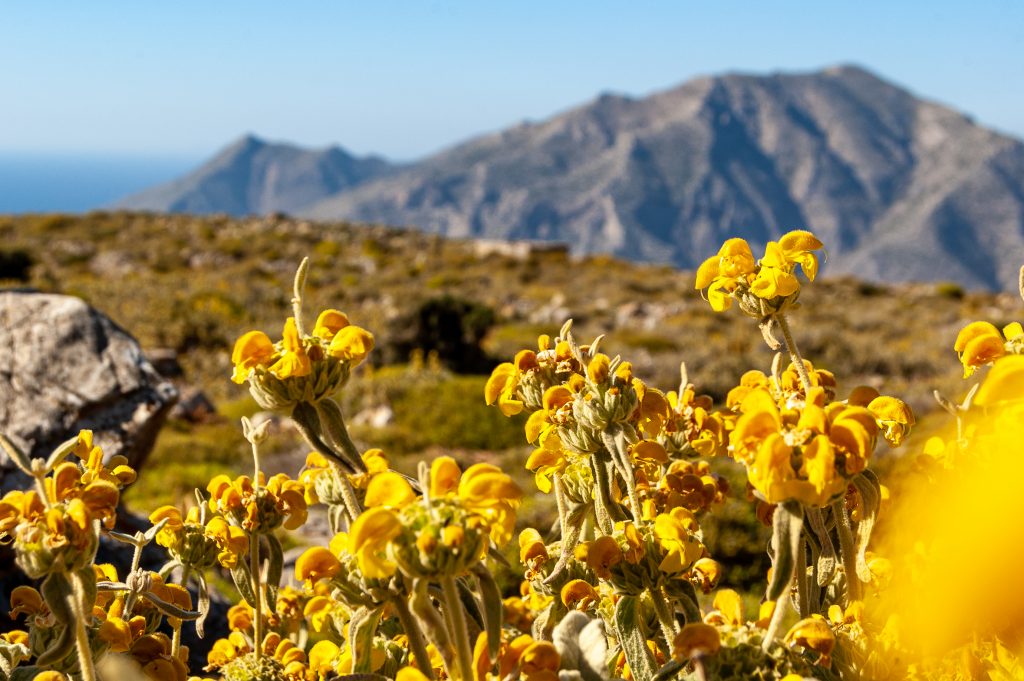
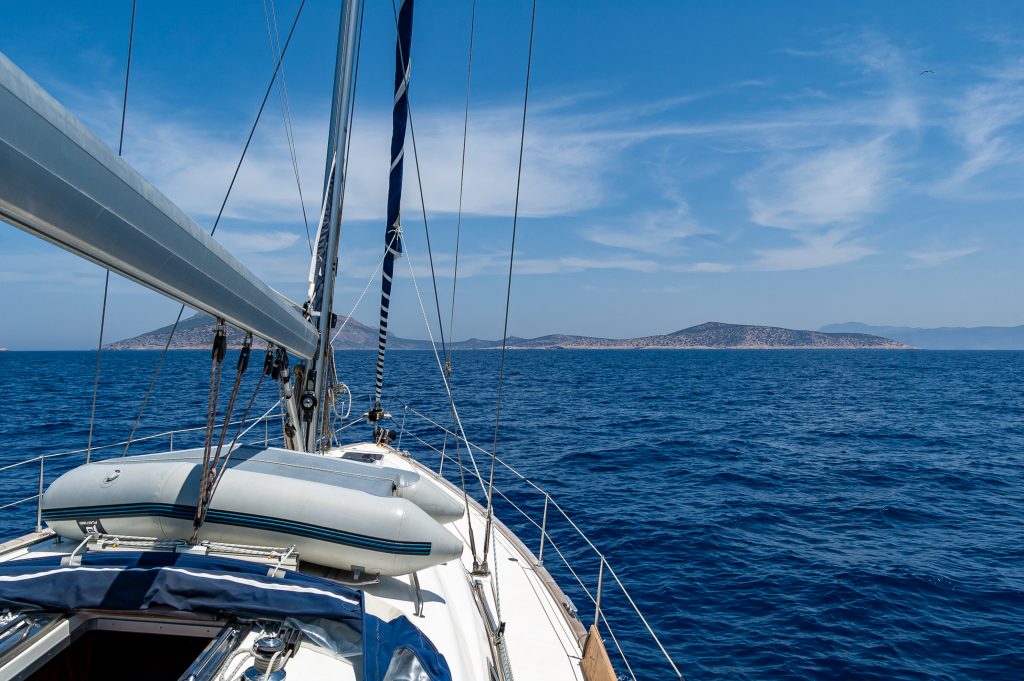
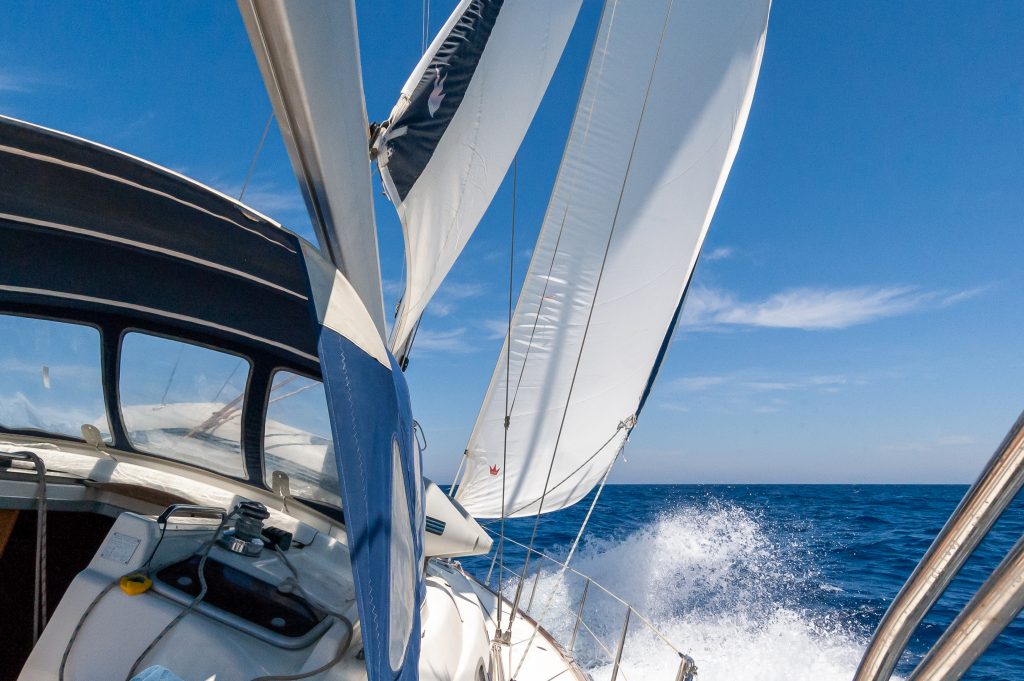
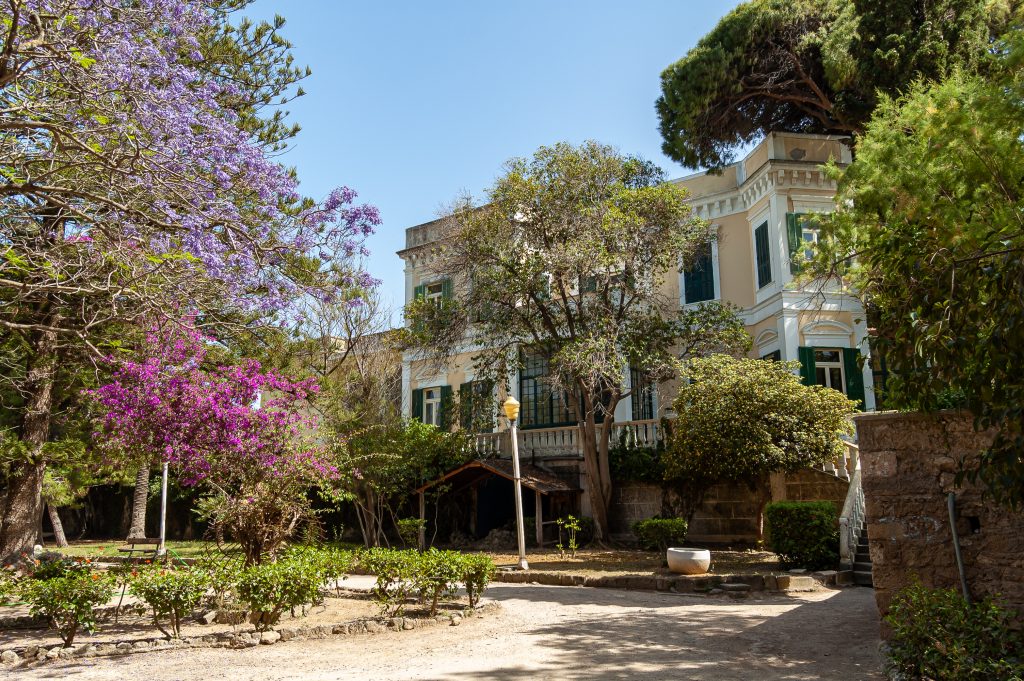
Nach zwei Törns von Samos und drei Trips von Athen aus wollte ich wieder einmal etwas Abwechslung. Rhodos ist im Frühjahr schon leicht mit Charterflügen erreichbar und unsere im letzten Jahr entdeckte Charterfirma ISTION konnte uns ein passendes Boot in Rhodos zu einem akzeptablen Preis anbieten. Peter R. konnte diesmal nicht dabei sein, Dafür war Peter P. diesmal wieder mit von der Partie und agierte auch als Co-Skipper, nachdem er 2007 gemeinsam mit mir den Segelschein gemacht hatte. Matthias und Heribert machten das Quartett komplett.
Einziger Fixpunkt auf der Reise sollte die Ostküste von Kreta sein: Sitía, Palékastro, Kato Zakros… Die letzten zwei Jahre war ich mit meiner Familie dort auf Sommerurlaub, und Jorgos unser Hotelwirt des „Marina Village“ war inzwischen unser Freund geworden. Die Region zwischen Rhodos und Kreta weist eine große Zahl an Inseln und Inselchen auf, so dass ich eine Menge unterschiedlicher Routenvarianten ausarbeiten konnte. Gefahren sind wir keine davon!
After two trips from Samos and three trips from Athens, I wanted some variety again. Rhodes is easily accessible by charter flights in the spring and our charter company ISTION, discovered last year, was able to offer us a suitable boat in Rhodes at an acceptable price. Peter R. could not be there this time, but Peter P. was again part of the game this time and also acted as the co-skipper after he had made the sailing licence together with me in 2007. Matthias and Heribert completed the quartet.
The only fixed point on the trip should be the east coast of Crete: Sitía, Palékastro, Kato Zakros… The last two years I was there with my family on summer vacation, and Jorgos our hotel manager of the „Marina Village“ had become our friend. The region between Rhodes and Crete has a large number of islands and islets, so I was able to work out many different route variants. We have not sailed one of them!
Freitag, 30. April 2010:
Peter und ich fliegen von Wien aus nach Rhodos und quartieren uns in einem kleinen Hotel ein. Wir würden am Samstag die Yacht übernehmen – eine Bavaria 46 Cruiser namens ERMÍS („Hermes“) – und am Sonntag, wenn Matthias und Heribert angekommen waren, lossegeln.
Samstag, 1. Mai 2010:
Nachdem wir das Boot erst am Nachmittag bekommen werden, machen Peter und ich ein wenig Sightseeing in Rhodos. Die Besichtigung des Großmeisterpalasts war sehr beeindruckend. Ebenfalls beeindruckend war das Platzangebot und die edle Ausstattung der ERMÍS. Auch nautisch war alles in Ordnung, mit diesem Boot werden wir die nächsten 14 Tage unsere Freude haben. Ich kann mich nicht erinnern, dass es irgendwelche ernsten Probleme mit der Technik gegeben hätte.
Friday, April 30, 2010:
Peter and I come by plane from Vienna to Rhodes and stay for one night in a small hotel. We would take over the yacht on Saturday – a Bavaria 46 cruiser called ERMÍS („Hermes“) – and sail off on Sunday when Matthias and Heribert have arrived.
Saturday, May 1, 2010:
Because we will get the boat not before the afternoon, Peter and I do a little sightseeing in Rhodes. The visit to the Grand Master’s Palace was very impressive. Equally impressive was the spacious layout and noble equipment of the ERMÍS. Also from a nautical view, everything was quite fine; with this boat we would have our joy for the next 14 days. I cannot remember any serious problems with the boat’s technical equipment.
Sonntag, 2. Mai 2010:
Heribert und Matthias sind gestern gut hier angekommen und wir haben uns an Bord eingerichtet. Nach einem gemeinsamen Überblick an Bord brechen wir gegen 10:00 Uhr von Rhodos auf. Heutiges Ziel ist die etwa 25 Seemeilen entfernte Insel Simi, wo wir im Stadthafen von Ano Simi, dem Hauptort, die Nacht verbringen werden. Wir treffen gegen fünf dort ein und bekommen noch einen Liegeplatz vor dem Stadtzentrum. Es ist Anfang Mai, wir wollen uns gar nicht vorstellen, was hier im Hochsommer los sein muss.
Montag, 3. Mai 2010:
Nach dem Frühstück machen wir noch einen Spaziergang durch die malerische kleine Stadt, bevor wir kurz vor Mittag wieder ablegen. Wir nehmen die Abkürzung durch den Kanal von Nímos, wo wir mit 2,2 m gerade noch durchkommen, aber wir sparen mindestens fünf Seemeilen. Wir sind ohnehin spät dran, bis Tilos, unserem nächsten Ziel sind es über 27 Seemeilen, aber wir haben einen guten Wind und können das Ziel hoch am Wind gerade noch direkt ansteuern. Im schönsten Abendlicht legen wir in Livádhia an.
Sunday, May 2, 2010:
Heribert and Matthias arrived here yesterday, and we make ourselves comfortable on board. After an extended overview on board, we leave Rhodes at about 10:00 a.m. Today’s destination is the island of Simi, about 25 nautical miles away, where we will spend the night in the city port of Ano Simi, the main town. We arrive there at about five and get one of the last berths in front of the city centre. It is the beginning of May; we do not want to imagine what will be going on here in midsummer.
Monday, May 3, 2010:
After breakfast, we take a walk through the picturesque little town before we leave again shortly before noon. We take the shortcut through the canal of Nímos, where we just can get over the shallows with no more 2.2 m depth, but thus we save at least five nautical miles. We are late anyway, until Tilos, our next destination it is over 27 nautical miles, but we have a good wind and can sail directly to the destination close-hauled. In the most beautiful evening light, we arrive at Livádhia.
Dienstag, 4. Mai 2010:
Am nächsten Morgen mieten wir zwei Motorroller und machen uns auf in die Berge. Auf einer malerischen Küstenstraße fahren wir bis Megalo Chorio, wo ein altes Kloster in einer pittoresken Berglandschaft erbaut ist. Mit einem Abstecher zu einem kleinen antiken Amphitheater kehren wir zurück in den Hafen. Nach einem stärkenden Abendessen brechen wir zur ersten Nachtfahrt auf. Es sind über 100 Seemeilen bis Sitía in Ost-Kreta und es gibt so gut wie keinen Ausweichhafen bis dahin. Wir haben wieder einen brauchbaren Wind, sind aber auch diesmal auf einem Am-Wind-Kurs unterwegs. Es war glaube ich diese Etappe, auf der wir das Motte des Törns gefunden haben: „Wir haben ja nichts zu verschenken!“ (nach einer blöden Werbung mit Niki Lauda).
Mittwoch, 5. Mai 2010:
Wir kommen gut zu Mittag in Sitía an. Es ist ein wunderbarer Maitag, blauer Himmel, Sonnenschein. Es ist herrlich! Wir machen einen Stadtspaziergang und verbringen einen ruhigen Nachmittag und einen gemütlichen Abend. Auch am nächsten Tag haben wir nicht viel vor, also kann es auch am Abend etwas länger werden…
Tuesday, May 4, 2010:
The next morning we rent two little scooters and set off for the mountains. On a scenic coastal road, we drive to Megalo Chorio, where an old monastery is built in a picturesque mountain landscape. After a detour to a small ancient amphitheatre we return to the harbour. We have a hearty Greek dinner at Livádhia, we set off for the first night trip. There are more than 100 nautical miles to Sitía in Eastern Crete and there is virtually no alternative port until then. We have a good wind again, but we are sailing once more close-hauled. I think it was this point where we found the motto of the trip: „We have nothing to give away!“ (after a stupid advertisement with Niki Lauda).
Wednesday, May 5, 2010:
At lunchtime, we arrive at Sitía. It’s a wonderful May day with blue skies and sunshine. It’s glorious! We take a city walk and spend a quiet afternoon and a relaxing evening. Also, the next day we do not have much to do, so it can get a little longer in the evening…
Donnerstag, 6. Mai 2010:
Sitía liegt ja an der östlichen Nordküste Kretas, also fahren wir heute um das Kap Sidheros herum an die nördliche Ostküste. Das Ziel der Etappe ist Kouremenos, der Hafen von Palékastro, wo wir Jorgos treffen werden. Vorher ankern wir aber noch vor Itanos, wo es antike Ausgrabungen zu besichtigen gibt. Da ich sie im letzten Sommer schon gesehen habe, bleibe ich als Ankerwache an Bord, während die Crew mit dem Dinghi in Land geht. Als die drei zurückkommen, hat sich der Himmel etwas eingetrübt und es schaut ein bisschen nach Regen aus.
Kouremenos ist ein kleiner, künstlicher Hafen hinter einem massiven Wellenbrecher, der für die lokale Fischerflotte und nicht für Charteryachten gebaut wurde. Die Wassertiefen nehmen hinter dem Molenkopf daher rasch ab, die Einfahrt ist eng, der Wind steht für ein Buganker-Heckleinen-Manöver nicht sehr günstig. Trotzdem, wenn wir heute Abend mit Jorgos fortgehen, werden wir wohl was trinken und mit dem Dinghi in der Nacht zur ankernden Yacht raus zu fahren, wäre auch kein Spaß. Also muss es wohl sein. In einer recht schmalen Lücke, nahe dem Molenkopf, machen wir nach einigem Zittern sicher fest.
Thursday, May 6, 2010:
Sitía is located on the eastern north coast of Crete, so today we will be sailing around Cape Sidheros to the northern east coast. The destination of the leg is Kouremenos, the port of Palékastro, where we will meet Jorgos. Before that, however, we set anchor off Itanos, where there are ancient excavations to visit. Since I saw them last summer, I stay on board as an anchor guard while the crew goes on land with the dinghy. When the three come back, the sky has darkened a bit, and it looks a bit like rain.
Kouremenos is a small, artificial port behind a massive breakwater built for the local fishing fleet, not touristic charter yachts. The water depths behind the pier head decrease rapidly, the entrance is narrow, the wind is not very favourable for an Aegean mooring manoeuvre. Nevertheless, if we leave tonight with Jorgos, we will probably have something to drink and to go out with the dinghy at night to the anchoring yacht would not be fun either. So, it has to be done. In a rather narrow gap, near the pier head, we are safely moored after some excitement.
Kurz darauf kommt einer der Fischer zu mir, ich müsse hier wieder weg, weil das der Liegeplatz eines Fischkutters sei, der gerade hereinkommt. Da ich weiß, dass es in griechischen Häfen keine reservierten Liegeplätze gibt (es sein denn, sie sind mit gelber Farbe als solche markiert), werfen wir nicht sofort die Leinen los, sondern ich frage ganz höflich und freundlich, wo ich mich denn hinlegen könne mit meinem fast zwei Meter tiefen Kiel, weiter innen wäre zu seicht und weiter draußen sei kein Platz. Mein höflicher Ton, meine scheinbare Bereitschaft zu kooperieren und meine Frage nach einer alternativen Lösung für mich sind genau das Richtige: Der Kutter legt im Päckchen an einem Kollegen an.
Mit Jorgos gehen wir in die „Hafenkneipe“, eine namenlose Grillbude in einem umgewidmeten Wohnwagen. Auf den Plastik-Sesseln vor dem Hafenbecken schmecken uns die Souvláki, Grillwürstchen und der griechische Salat hervorragend und auch der Bierkonsum kommt nicht zu kurz – wir haben ja nur einen Heimweg von 300 m!
Shortly afterwards, one of the fishermen comes to me: I must leave here again, because this is the berth of a fishing boat that is just coming in. Since I know that there are no reserved berths in Greek ports (if there were, they would be marked with yellow colour), we do not immediately cast off the lines, but I ask quite politely and kindly where I could possibly get berthed with my almost two meters deep keel, further inside it would be too shallow and further outside there is no empty space. My polite tone, my apparent willingness to cooperate and my question about an alternative solution for me are just the right thing to do: the fish-cutter moors rafting to one of his colleagues.
With Jorgos we go to the „Quayside Bar“, an unnamed barbecue stall in a repurposed caravan. On the plastic armchairs in front of the harbour basin, the Souvláki, grilled sausages and the Greek salad taste excellent and the beer consumption is not neglected, either – we only have a way home of 300 m!
Freitag, 7. Mai 2010:
Heute haben wir die kürzeste Tages-Strecke des ganzen Törns vor uns. Gute 10 Seemeilen sind es bis zur Bucht von Kato Zakros, wo wir zwei Nächte und drei Tage bleiben wollen. Im nördlichen Teil der Bucht gibt es auf sandigem Grund gute Ankermöglichkeiten und das „Akrogialli“, ein vorzügliches Grillrestaurant, ist ein guter Versorgungsposten.
Bevor wir aufbrechen lässt uns Jorgos noch die Duschen des Hotels benutzen und serviert einen starken Espresso. Die Fahrt verläuft dann ohne besondere Ereignisse, es herrscht nahezu Windstille und wir müssen die ganze Strecke den Motor benutzen. Es kündigt sich ein Wetterumschwung an. Es soll ein Südwind aufkommen, der Staub aus der Sahara nach Kreta trägt und nicht besonders angenehm ist. Selten frischt er jedoch bis zur Sturmstärke auf…
Friday, May 7, 2010:
Today we have the shortest leg of the whole trip ahead of us. A good 10 nautical miles to the bay of Kato Zakros, where we want to stay two nights and three days. In the northern part of the bay there are good anchorages on sandy ground and the „Akrogialli“, an excellent barbecue restaurant, is a good supply post.
Before we leave, Jorgos lets us use the showers of the hotel and serves a strong espresso. The ride then proceeds without any special events, there is almost no wind, and we have to use the engine all the way. A change of weather seems to be looming. A southerly wind is expected to come up, carrying dust from the Sahara to Crete and not particularly pleasant. Rarely, however, does it freshen up to the strength of a storm…
Samstag, 8. Mai 2010:
Wir nutzen den Tag für eine Wanderung zur Pelekitá Höhle, ca. eineinhalb Stunden von Kato Zakros entfernt. Bei der Fahrt an Land fällt der Außenborder des Dinghis aus – es dürfte was mit der Kühlung zu tun haben. Bevor wir also aufbrechen können, frage wir Nikos, den Wirt des „Akrogialli“, ob es im Ort einen Mechaniker gebe, der sich des Problems annehmen könne. Nikos zögert nicht lange, packt mich mit dem Motor auf die Ladefläche seines Pickups und fährt mit mir ins Bergdorf Zakros, wo der Mechaniker einen kleinen Kieselstein aus der Kühlwasserleitung entfernt, das war’s! Er nimmt dafür ein paar Euros, Nikos schaut bei seiner Frau vorbei, die im Ort einen kleinen Laden betreibt und schon fahren wir wieder runter an den Strand.
Die kleine Wanderung zur Höhle tut uns gut. Für morgen ist eine weitere Tour durch die „Schlucht der Toten“ geplant. Am Nachmittag wollen wir zur längeren Nachtfahrt nach Kastelorizo aufbrechen. Also bestellen wir bei Nikos noch Proviant und gehen an Bord. Dabei mache ich zum ersten und letzten Mal den Fehler, das Dinghi samt Motor am Heck angehängt im Wasser zu lassen.
Saturday, May 8, 2010:
We use the day for a hike to the Pelekitá cave, about an hour and a half from Kato Zakros. When going ashore, the dinghy’s outboard fails – it may have to do with cooling. So, before we can leave, we ask Nikos, the owner of the „Akrogialli“, if there is a mechanic in the village who can deal with the problem. Nikos doesn’t hesitate for long, takes me with the engine on the loading platform of his pickup truck and drives with me to the mountain village of Zakros, where the mechanic removes a small pebble from the cooling water pipe, that’s it! He takes a few euros for it, Nikos looks over to his wife, who runs a small shop in the village, and then we drive back down to the beach.
The small hike to the cave is a good exercise for us. Another tour through the “Gorge of the Dead” is planned for tomorrow. In the afternoon we want to leave for the longer night trip to Kastelorizo. So we order provisions from Nikos and get on board. For the first and last time I make the mistake of leaving the dinghy, with the engine attached, tied to the stern in the water.
Der Südwind, tatsächlich kommt er fast aus Südost, frischt in der Nacht deutlich auf und treibt einen unangenehmen Schwell in die Bucht, die nur eine gefährliche Windrichtung kennt: Südost! UM drei Uhr früh werde ich munter, weil mir die Bewegungen der Yacht nicht gefallen, sie stampft massiv in den umlaufenden Wellen und ruckt immer wieder unangenehm in die Kette. Ich setze mich eine Weile ins Cockpit und beobachte die Situation: Es ist eindeutig zu erkennen, der Anker hält nicht. Bei jeden Ruck driftet die ERMÍS ein Stück näher an die Felswand im Nordwesten der Bucht. Es ist (noch) nicht dramatisch, aber so können wir nicht bleiben. Da es im geschützten Teil der Bucht keinen Sandboden, sondern nur Fels gibt, müssen wir weg. Aber nun hängt das Dinghi hinten dran und der Außenborder ist auch noch dran!
Wir starten den Motor der Yacht und tuckern in Richtung der windgeschützten Ecke der Bucht, wo auch die Wellen deutlich ruhiger sind. Dort fährt Heribert enge Runden, während wir anderen drei zunächst den Außenborder bergen. Das ist kein Spaß in der stockdunklen Nacht auf dem schwankenden Schlauchboot. Nachdem der Motor gesichert ist, stauen wir das Beiboot an Bord und verlassen die Bucht, die gestern noch so friedlich und geschützt wirkte.
The southerly wind, in fact, it comes almost from the Southeast, refreshes clearly during the night and pushes an unpleasant swell into the bay, which has only one dangerous wind direction: Southeast! At three o’clock in the morning I get awake because I don’t like the movements of the yacht, she stomps massively in the incoming waves and repeatedly jerks unpleasantly into the chain. I get seated in the cockpit for a while and observe the situation: it is clearly recognizable: the anchor does not hold. With each jerk, the ERMÍS drifts a bit closer to the rock face in the Northwest of the bay. It is not (yet) dramatic, but we cannot stay that way. Since there is no sandy bottom in the protected part of the bay, only rock, we have to leave. But now the dinghy is fastened to the stern and the outboard still attached!
We start the motor of the yacht and chug towards the wind-protected corner of the bay, where the waves are much calmer. There Heribert drives small circles, while the other three start with recovering the outboard. This is no fun in the pitch-dark night on the swaying inflatable boat. After the engine is secured, we lash the dinghy on board and leave the bay, which yesterday still seemed so peaceful and protected.
Sonntag, 9. Mai 2010:
Aber wohin? Kastelorízo vor der türkischen Küste ist jetzt keine Option mehr, wir würden frühestens bei Nachtanbruch dort ankommen und haben jetzt auch keinen neuen Proviant bekommen. Also beschließen wir, nach Pigádhia auf Karpathos auszuweichen, die 60 Seemeilen bis dorthin sollten gut zu bewältigen sein, schließlich brechen wir ja sehr früh auf…
Der Wind dreht im Lauf des Morgens weiter nach Ost und wir finden uns bald hart am Wind segelnd wieder: „Wir haben ja nichts zu verschenken!“ Nach etwa elf Stunden schönsten Segelns legen wir in der Hauptstadt von Karpathos an. Es ist noch einmal alles gut gegangen, aber der nächtlich Stress wird mir eine Lehre sein!
Montag, 10. Mai 2010:
Karpathos ist zweifellos eine sehr schöne Insel. ich war 1998, nach der Geburt unserer Tochter schon einmal hier. Wie damals mieten wir uns einen kleinen Geländewagen und fahren in die Berge. Mesochório, Ólympos, und die unbewohnten schroffen Bergzüge des Norden – es ist ein wunderbarer Ausflug, den wir hier machen. Es dauert auch bis nach Sonnenuntergang, bevor wir wieder im Hafen sind.
Sunday, May 9, 2010:
But where shall we go? Kastelorízo off the Turkish coast is not longer an option, we would arrive there at night at the earliest and have not received any new provisions now. So, we decide to go to Pigádhia on Karpathos. The 60 nautical miles to get there should be manageable, after all we are leaving very early…
The wind turns further east in the course of the morning, and we soon find ourselves sailing closely hauled again: „We have nothing to give away!“
After about eleven hours of beautiful sailing we set off in the capital of Karpathos. Everything went well again, but the nightly stress will be a lesson to me!
Monday, May 10, 2010:
Karpathos is undoubtedly a very beautiful island. I was here once before in 1998 after the birth of our daughter. Like then, we rent a small off-road vehicle and drive into the mountains. Mesochório, Ólympos, and the uninhabited rugged mountain ranges of the north – it is a wonderful excursion we make here. It also takes until after sunset before we are back in port.
Dienstag, 11. Mai 2010:
Wir sind nun auf „direkter“ Strecke ca. 90 Seemeilen von Rhodos entfernt und haben noch vier Tage Zeit. Spätestens am Freitagabend sollen wir das Boot in der Marina von Rhodos festmachen. Was also fangen wir mit der restlichen Zeit an? Zunächst beschließen wir, dass wir wieder in Simi Halt machen, weil wir von dort locker in einem halben Tag in Rhodos sein können. Diesmal wollen wir aber vor dem Kloster Panormitis ankern, einer perfekt geschützten Bucht bei allen Windrichtungen.
Wir beschließen, einen Tag früher nach Rhodos zurückzufahren. Heribert und Matthias haben zu Beginn der Reise nichts von Rhodos mitbekommen und auch Peter und ich wollen noch etwas mehr von dieser faszinierenden und historisch bedeutenden Stadt sehen. Der versäumte Tag in der Natur von Kato Zakros wird durch einen Tag Kultur in Rhodos kompensiert.
Als Zwischenstation nach Simi bietet sich die kleine Insel Chalki an, deren Hauptort eine gut geschützten und großen Hafen besitzt. Also auf nach Chalki! Die frische Brise dreht weiter nach Ost – wir fahren wieder hart am Wind! Kurz nach 17:00 sind wir an einem brandneuen Schwimmsteg festgemacht und nutzen das glasklare Wasser zu einem Sprung ins kühle Nass…
Tuesday, May 11, 2010:
We are now on the „direct“ route approximately 90 nautical miles from Rhodes and have four days left. We should bring the boat into the marina of Rhodes by Friday evening at the latest. So what do we do with the rest of the time? First of all, we decide to stop on Simi again, because from there we can easily be in Rhodes in half a day. This time we want to anchor in front of the Panormitis Monastery, in a perfectly protected bay from all wind directions.
We decide to go back to Rhodes a day earlier. Heribert and Matthias didn’t notice anything of Rhodes at the beginning of the trip and Peter and I want to see a little more of this fascinating and historically important city. The missed day in the nature of Kato Zakros is compensated by a day of culture in Rhodes.
A stopover on the way to Simi is the small island of Chalki, the main town of which has a well-protected and large harbour. So off to Chalki! The fresh breeze continues to turn east – we are sailing close to the wind again! Shortly after 5 p.m. we are safely moored at a brand new floating pontoon and enjoy the crystal clear water for a short swim in the bay.
Mittwoch, 12. Mai 2010:
Nach Panormitis sind es jetzt nur mehr 25 Seemeilen, also nutzen wir den Vormittag zu einem Spaziergang auf Chalki, besichtigen dann die verlassenen Siedlungen auf Alimia vom ankernden Boot aus und erreichen die Ankerbucht auf Simi noch vor einem soektakulärem Sonnenuntergang.
Wednesday, May 12, 2010:
The leg to Panormitis takes only 25 nautical miles from here, so we make use of the morning for a walk on Chalki. Then we inspect the abandoned settlements on Alimia from the anchored boat and reach the bay of Panormitis on Simi just before a spectacular sunset.
Donnerstag bis Samstag, 13. bis 15. Mai 2010:
Die letzte Etappe nach Rhodos verläuft ohne nennenswerte Zwischenfälle. Am Freitag besichtigen wir noch einmal die Altstadt von Rhodos und fliegen am Samstag nach der Yachtübergabe zurück nach Hause.
Auch dieser Teil des ägäischen Meeres hat uns sehr gut gefallen!
Thursday, May 13th, to Saturday, May 15th, 2010:
The last sailing leg to Rhodes runs without any significant incidents. On Friday we visit the old town of Rhodes and the Greatmasters palace again and fly back home on Saturday after the yacht handover.
We liked this part of the Aegean Sea also very much!
118 Fotos mit Musik von Christos Tsialmoulis und Lizeta Kalimera


